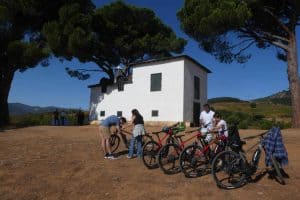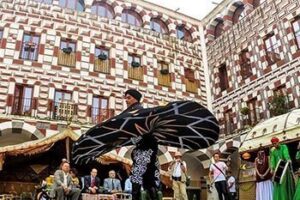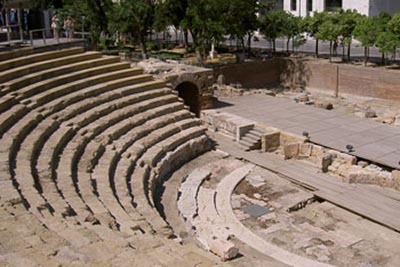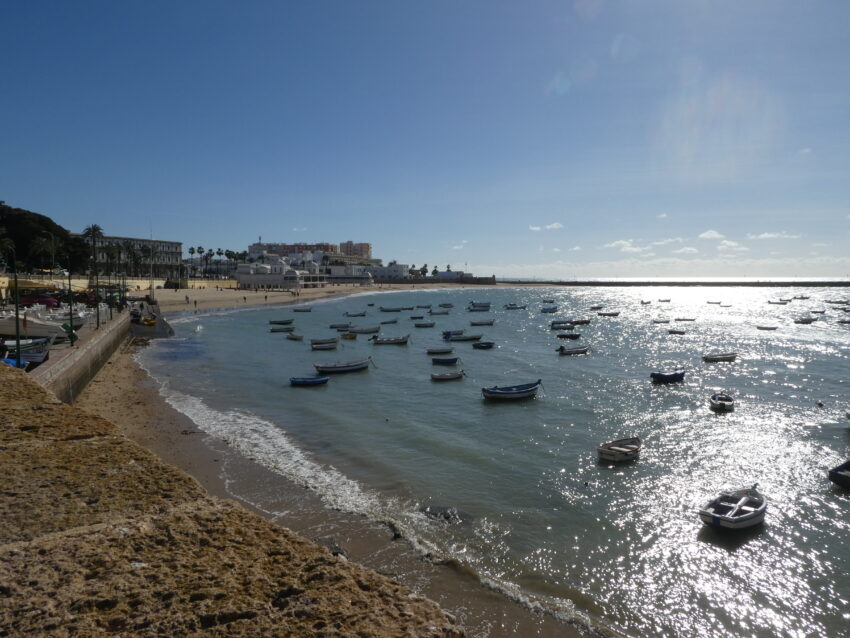
Meeting The Masters of the Guitar in Andalusia, Spain
By Richard Frisbie
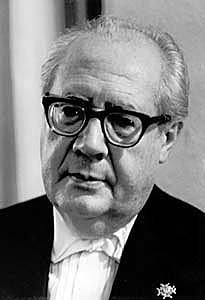
The Iberia flight from Madrid to Malaga, scheduled to last 75 minutes, could have been shorter without the route over Malaga Bay looping down the Costa del Sol offering a slideshow of colorful boats and beautiful beaches through the airplane windows.
Welcome to Andalusia, where sherry, flamenco, and the guitar are the lifeblood of some of the friendliest people in Spain. This is where the most famous flamenco musicians and performers still live.
I came to meet them.
Andres Segovia: Virtuoso on Guitar
Andres Segovia is perhaps the best-known guitarist in the classical music world. Before his death in 1987 he’d achieved more honors in his nearly century of life than any other Spanish musician.

This virtuoso classical guitarist composed, transcribed, and performed on the world stage while promoting the guitar as an important concert instrument, using his unique style and personality to win over audiences and critics.
Segovia’s Museum in Linares
The Andres Segovia Museum is in his birth town, Linares, outside of Jaen, Spain.
We traveled there to see rooms of personal items, guitars, musical scores, his piano, and even a plaster cast of his hands, which were so big he had an enviable range on guitar strings that enabled his unique sound.
The museum also contains a performance space, with stage, on the ground floor, where we attended a concert that evening.
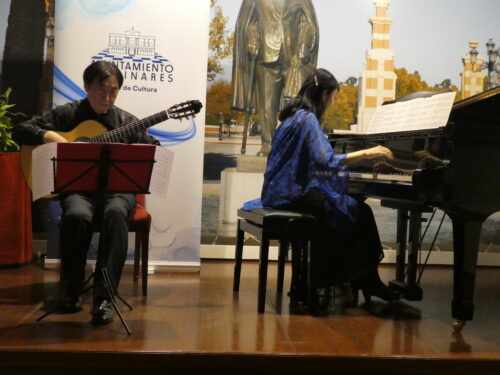
If you get a chance to catch a performance there, do go. It is an intimate and charming space, and the museum is a great introduction to what became the first of many famous Spanish musicians I’d never heard of.
On to Granada
Another reason for the visit was to explore the guitar makers of Spain, for without them the classical and flamenco musicians Spain is famous for could not exist.
To that end, we found our way to Granada, which has 43 guitar makers within its province. Antonio de Torres Jurado (Torres) born in 1817, is considered the father of the guitar.
He did not invent it, but his work perfecting the shape and dimensions, which are still followed today, helped to create the modern guitar, the one that Segovia played, legitimizing it as a concert instrument.
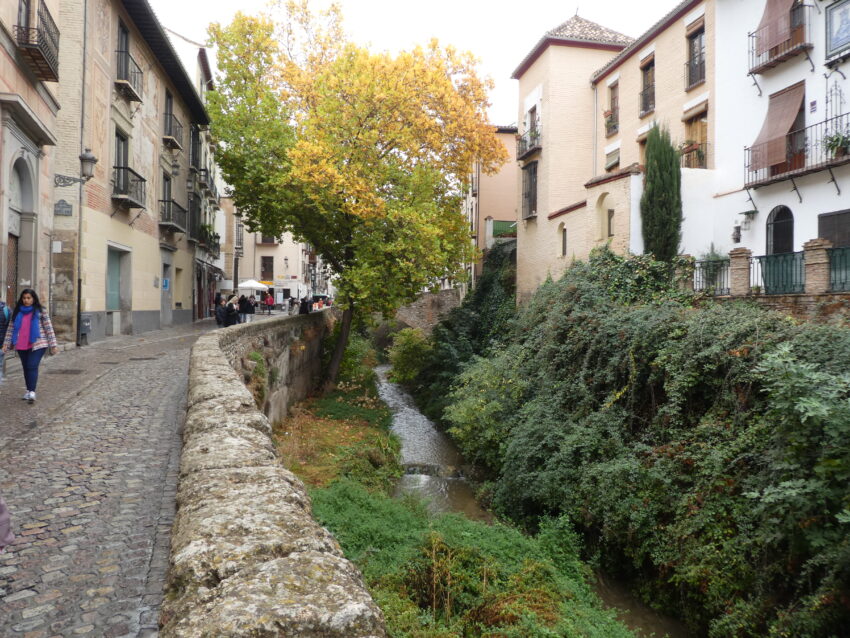
Manuel Bellido: A Famous Luthier in Granada
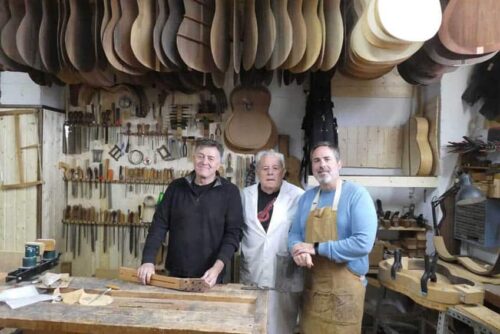
One of the most famous living luthiers is Manuel Bellido. We met him for a tour of his workshop with his sons, who are themselves also established luthiers.
Standing before a wall of chisels and planes of various sizes, some of which were handmade by the master, and under a hanging collection of guitar backs and fronts in various kinds of wood and sizes, his son Morris explained how guitars were made, both in style and fashion.
If you can somehow gain admittance to their workshop, you must go. If not, they have a website with their guitars amply displayed.
We visited several other luthier’s studios, including those of John Ray, who, besides being a luthier, is most notably the editor of the new edition of the classic: “La Escuela Granadina
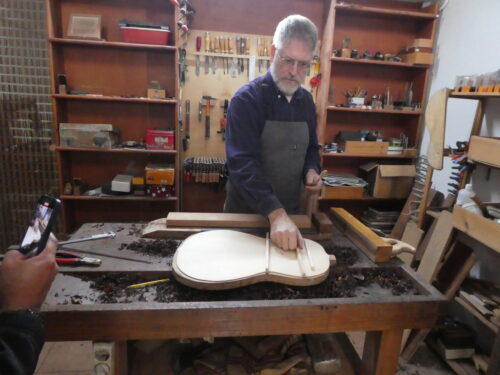
de Guitarreros” or “The Granada School of Guitar Makers”, and Antonio Marin Montero, the venerable artist whose early skills earned him a place under the masters of his time, and whose instruments are widely sought after today.
In fact, there is a growing trend of guitars as investments, similar to what has taken place with other stringed instruments such as violins and cellos.
Case in point, a Torres guitar for sale for $24,000 ten years ago recently sold at auction for $180,000. A visit to the sherry maker Antonio Espinosa de Los Monteros in Jerez revealed an upstairs guitar museum with more than 100 guitars and stringed instruments.
Downstairs the sherry was fabulous, having earned international gold medals in its first year of production. With owner Antonio’s guidance, I accepted a generous offer of a taste of his finest, which is only available to top Michelin restaurants and often sells for 100 euros a glass. It was the smoothest sherry I ever tasted!
If sherry was always this flavorful (and my pockets were very deep) it is all I would drink. As a further compliment, he asked me to sign his guest book. I wrote:
“Antonio: you honor the grapes as you honor my palette – muchas gracias! Richard Frisbie
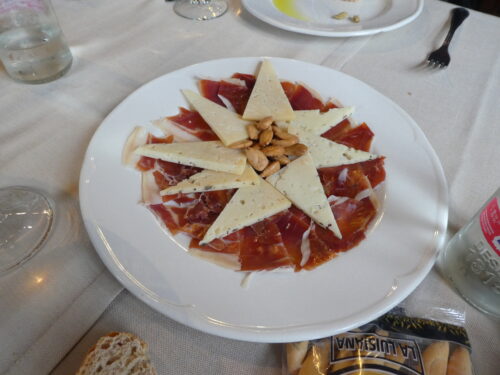
On the way to visit the Alhambra, we paused for sustenance at the classic restaurant, Albaycin, at the Mirador de Morayama.
With their own excellent in-house wines and olive oil, panoramic views of the Alhambra, and delicious foods, we were well-served as we waited for our appointed time.
(Visits to the Alhambra are by appointment made ahead of time, so be sure to book tickets online well in advance of your visit.) If you can, allow time to eat here as well.
Speed Tour of Alhambra
Ours was a speed tour of the Alhambra excellently delivered by Pablo Romero. We had two hours to see what some have spent days enjoying. It is a beautiful, must-see spot, but hard to fully enjoy or appreciate at a trot.
Jokes, historical information, and entreaties to hurry flew as fast as our feet could carry us! Built and added to over centuries, there are palaces, gardens, vistas, ornate rooms, fountains, hedges, intricate tile work, and elaborate carvings and paintings on many levels.

It is all a blur in my mind, but if I could review it in slow – even stop motion – I would still admire the style and workmanship. It is stunning! They locked the gate as we left.
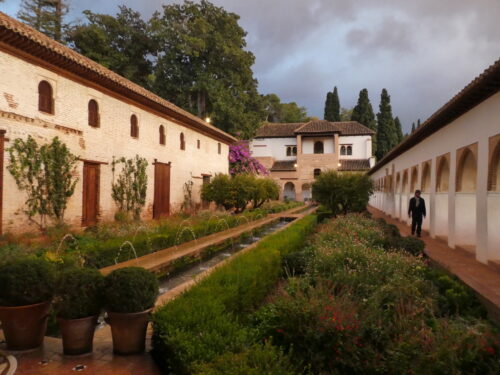
Gypsy Caves
In the US we have learned that “gypsy” is a derogatory term, substituting “Roma” when referring to them. It is different in Spain. Most of the flamenco performers today are gypsies. Many descended from original families of flamenco performers.
Everyone we met referred to themselves as gypsies – unabashed, unapologetic, and unaware of any stigma involved. So here I use the word gypsy with all the reverence and dignity they possess.
Across from the Alhambra, gypsies created elaborate caves dug into the hillside. That evening we navigated a winding, narrow street to reach Vente El Gallo, a gypsy flamenco performance space and restaurant.
The arched entries and domed ceilings of the warren of tiny rooms, all roughly plastered and painted white, with stairs going every which way to access them, showed the inventive nature of the gypsies.
Adding another room was simply a matter of digging it out. Cleverly, several of the rooms, or dining spaces, opened out over a large room with a stage on the far side. We were seated in one for dinner and a show.
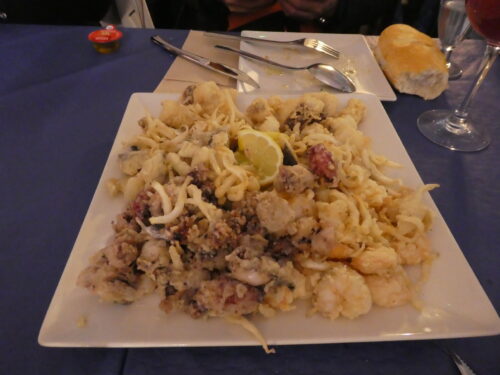
After ordering drinks (sherry of course) and the ubiquitous tapas plates for a family-style dinner, Manuel Fernando, one of the evening’s performers, joined us at the table for a brief flamenco guitar demonstration before passing his instrument around for a hands-on flamenco lesson.
Feeling the vibrations from the guitar resonate in my chest helped me to feel the lure and excitement of the rhythmic music more than any verbal explanation could. The music is alive!
The performance that followed was acoustically, visually, and sensually exciting, made more so by my having held the actual instrument he was playing on stage. One does not just attend a flamenco show; one lives breathes and feels its embracing energy.
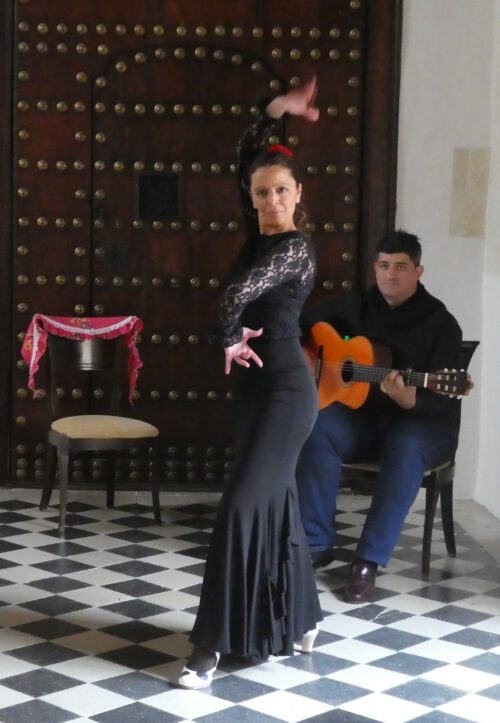
The food was part of the experience, but far from the best part, and not necessary for the show.
Manuel Lozano Gomez, Flamenco Guitarist
In Jerez de la Frontera we visited the Pena Los Cernicalos & Carbonero School of Flamenco. A Pena is a cultural association of flamenco lovers usually centered around a flamenco luminary. This Pena, founded in 1969, is the oldest in Cadiz, and the third oldest in the world.
Flamenco guitarist Manuel Lozano Gomez, who performed as “El Carbonero” for more than 50 years, was in the middle of a guitar lesson with his nine-year-old grandson when we met.
He mentioned the generations of students he taught, some his relatives, and how satisfying it was to introduce younger generations to flamenco. Then he played different songs to show that he only plays uplifting flamenco, not the sad and/or angry tunes others may be known by.
His kindly face with sparkling eyes and a ready smile matched the tenor of the music perfectly. He is a huggable 73-year-old who I hope has many more years to pass his musical baton on to future generations.
Paco Cepero, Flamenco Guitar Master

At 80 years old, Paco Cepero is the oldest flamenco guitarist we met. He is also the most famous – a man who has received every award and honor, performed with the top flamenco artists of his time, recorded solo albums and composed many well-known works still performed today.
We met him over a quotidian tapas lunch at Casa Palacio Maria Luisa, an elegant restaurant with a spacious private room where we could visit over sherry and good food.
He did not perform for us but shared his wisdom, good humor, and some amusing anecdotes he admitted did not translate well. What I can tell you is that he said “No one can teach you how to create. It must come from inside.”
And he shared that his children and grandchildren all thought they could pick up a guitar and know how to play without practicing. Sadly, his is not a family legacy of flamenco guitarists.
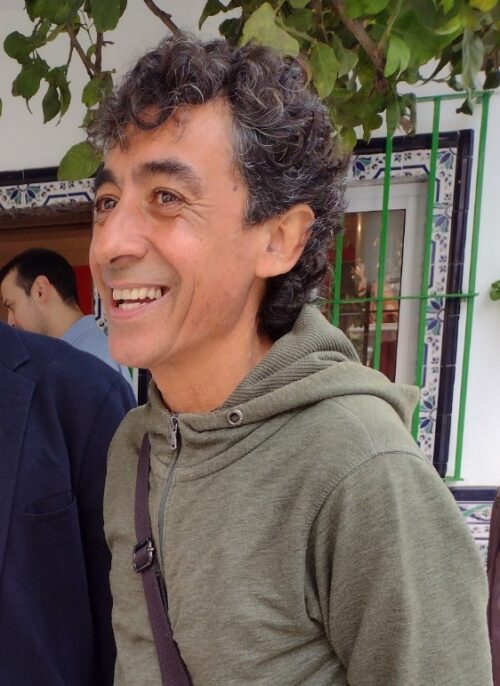
Tomas Moreno Romero, Flamenco Guitar Master
Tomas Moreno Romero is a bridge to the jazz, rock, and fusion flamenco today’s young Spaniards listen to. “Tomasito” as he is known, sings, plays the guitar, and dances, creating music videos and live performances that engage you with his impish grin and unbounded talent and energy.
Tomas invited us into the gypsy compound of his youth, where his mother still lives, in the historic Santiago district of Jerez. He admitted to being a bit hung over, we all did.
Then he graciously toured us through his mother’s home and the courtyard, so typical of this gypsy neighborhood. After a group photo with his mom, we thanked them and left.
Walking down the alley feeling how blessed we were, he called after us. We turned to see a brief flamenco dance, a wide smile and wave, and he was gone. It was an amazing experience!
Andalusia Tapas
Of course, we had to eat, and there were platters of tapas everywhere every day. Some of the most remarkable dining experiences morphed from tapas to haute cuisine.
I can recommend El Faro Restaurant just a half block from the beach in Cadiz which surprised us with baked fish that a humorous maître d’ broke out of its salt prison and deboned for us. The presentation was only exceeded by the taste!
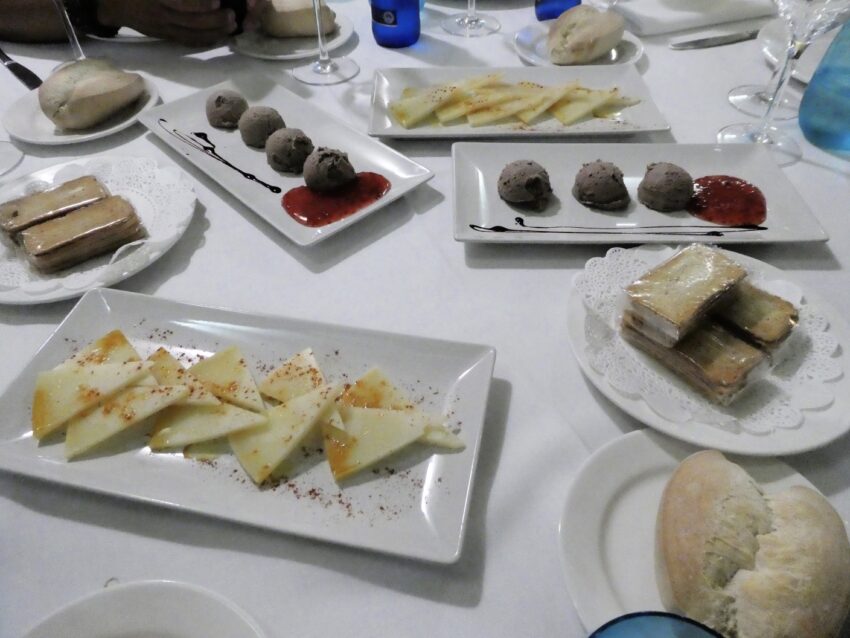
Puro Arte in Cadiz is known for its incredible flamenco stage show. It was the best we experienced during this flamenco guitar immersion tour. It seems an unlikely place to eat, but do not pass up their food. They did everything right.

There were other fine penas, and other towns with Flamenco Festivals (think of mid-July to early August as Festival time). Among them, Marchena, is one town where they have the “Fiesta de la Guitarra” each summer, and nearby Ecija is another with their own festival.
And there were other amazing families of musicians, such as the nephew of Melchor de Marchena, who were happy to spend their time showing off the flamenco that had nurtured them.
It turns out that Andalucia, a welcoming and sunny region rich in Roman history, is the birthplace of Sherry and Flamenco. Go there.
- Valentine’s Day Suggestions…for that Special Person - January 22, 2026
- Missouri Sports Travel Adventure: From Landmarks to Ballparks - January 21, 2026
- What First-Time Visitors Get Wrong About Visiting Iceland - January 15, 2026


